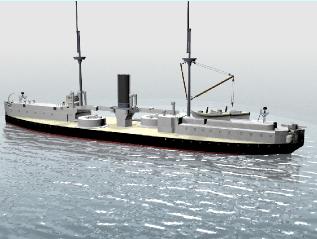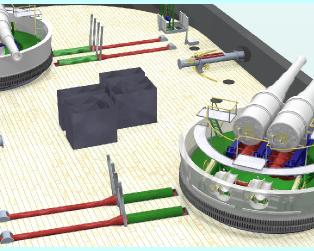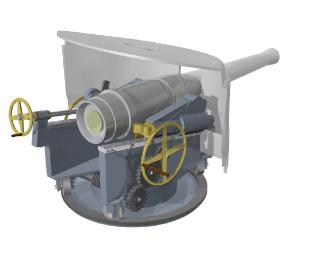| Home | Wiki | Docs | Sources | Contact |

| Overview of HMS Colossus |  |  |
HMS Colossus was laid down in Portsmouth on 6 June 1879, and launched on 21 May 1882 taking three years to build. The design was by Nathaniel Barnaby, the Director of Naval Construction at the time. She was 325 ft long, 68 ft wide and had a mean draught of 26 ft. Normal displacement was 9,150 tons, of which hull and armour accounted for 6,150 tons. Colossus represented a number of firsts in British naval shipbuilding:
But Colossus also represented the end of some design concepts, being among the last of the ships protected by an armoured citadel. [2] Colossus was launched in 1882 but was not completed until 31 Oct 1886. Most of the delay was waiting for new guns, which were manufactured at the Government’s Woolwich Arsenal using a combination of steel and wrought iron. The 12 inch Mk II guns initially fitted were not a success (one of the same design burst during trials in Collingwood), and the captain of Colossus was instructed on the first cruise not to fire the guns. Colossus's Mk II guns were eventually replaced by four all-steel 12 inch Mk IV Rifled Breech-Loading (RBL) guns of 25 calibres in two turrets protected by a central armoured citadel. Each gun fired a shell weighing 714 pounds at a muzzle velocity of 1,914 ft/sec capable of piercing 20.4 inches of wrought iron at 1,000 yards. The full (battering) charge was 295 pounds of Prismatic Brown powder. A pair of 14 inch torpedo tubes were mounted amidships, one on each side within the armoured citadel's protection. |
 |
|||
 |
||||
|
She carried a secondary battery of five 6 inch RBLs: two broadside in the forward superstructure, two in the aft superstructure and one at the stern in a rotating mount. The armoured Citadel was formed of 18" of compound armour on the beams reducing to 14" on the internal bulkheads. The turrets had 16" of compound armour on the face, reducing to 14" at the sides. The conning tower had 14 inch compound armour. The deck above the gun deck was made from 3 inch armour plating, as did the armoured deck above the magazines and shell rooms. Teak backing was between 2 and 10 inches. The total weight of armour was 2,414 tons[2] Colossus was a ‘passable’ sea boat, having a high metacentric height (9 foot) which gives a quick and deep roll of about 9 seconds side to side.[2] |
 |
History Colossus took over seven years to complete, running speed trials in January 1884 and gun trials in July 1885. Commissioned at Portsmouth 13 April 1886 for Particular Service and in August joined the Channel fleet for tests. Detached for Special Duties in October and then being formally completed, she was sent to the Mediterranean in April 1887 where she remained for six and a half years, returning to take up duty as coastguard ship at Holyhead in November 1893. Eight years later, in 1901, Colossus was paid off and passed into Fleet Reserve at Portsmouth; she was transferred to Dockyard Reserve in 1902, but in January 1904 was given a fresh lease of life as tender to HMS Excellent with duty as guardship at Cowes in August 1904. She was finally ordered to be sold in September 1906 and was eventually towed away for breaking in 1908. [2] Colossus's sister ship, HMS Edinburgh, was used as a target for experimental firing in 1908. She was fitted with modern armour plates fully supported for testing hits at oblique angles with filled armour piercing (A.P.) shell as were then being supplied for war use. As a result of these trials the Controller of the Navy (Jellicoe) instructed the Director of Naval Ordnance in October 1908 to produce designs for an A.P. 12-in shell and above that would pierce thick armour at oblique impact in a fit state for bursting. Jellicoe then hoisted his flag as C.O. of the Atlantic fleet, but due to technical blunders in his absence this instruction was not carried out. This was to have profound impact on the effectiveness of British shells at Jutland.[2] |
Engineering
Colossus was powered by 2 sets of inverted direct compound engines by Maudsley. IHP [Indicated horse power – a measure of power used of reciprocating steam engines] 7,488 giving 16.5 knots per hour[*]
HP cylinder 58”, 2 x LP cylinders 74” dia, stroke 39”[picture]. The engines were fitted with surface condensers.
The engines were supplied steam from 8 main and 2 auxiliary elliptical boilers working at a pressure of 64 pounds on the square inch.
Propulsion was through twin screws, 4 bladed of 17’8” diameter [2].
[*] In the 1880s and 1890s the term 'Knot' was a unit of distance equal to 1 nautical mile. Charts might show distances, for example between coaling stations, as a number of knots, and the endurance of a ship could likewise be expressed as a number of knots. Speed, therefore, was expressed in Knots per Hour. However, during this period, it was also common to shorten Knots per Hour to simply Knots, and it was left to the context of use to determine whether it referred to a distance or speed. In the 20th Century, Knots invariably means a speed in nautical miles per hour
 |  | ||
| (c) 2008 Rob Brassington, all rights reserved | |||